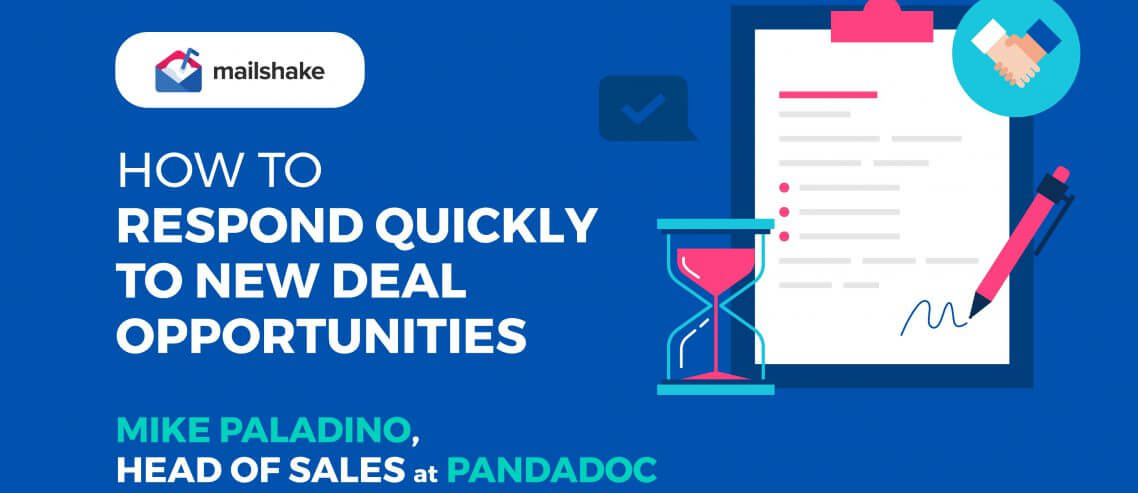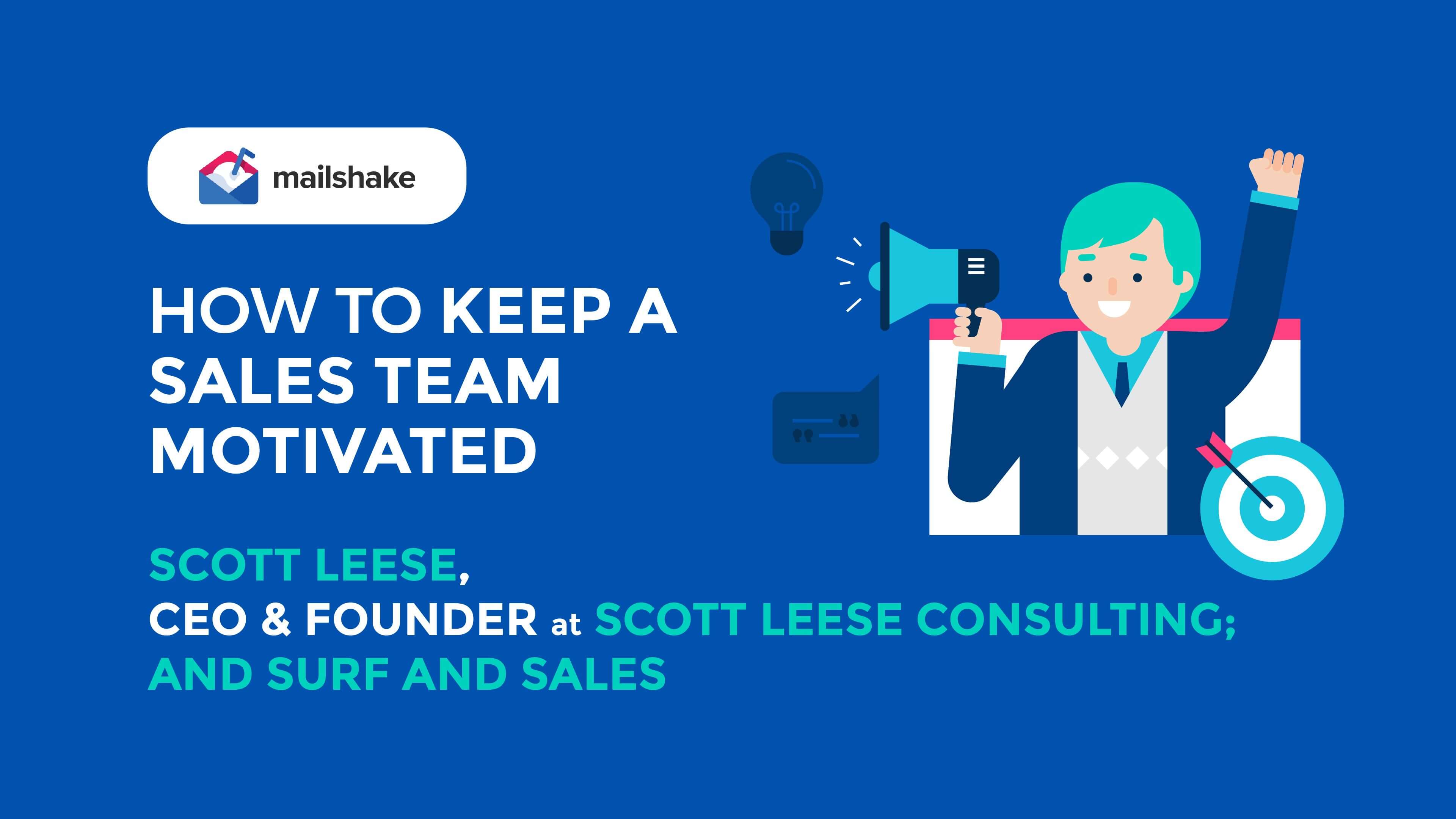How to Respond Quickly to New Deal Opportunities

Contents
Speeding up the sales cycle is a goal for most sales reps.
After all, a faster sales cycle means more time to make sales.
I sat down with Mike Paladino, Head of Sales at PandaDoc, to find out how he goes about speeding up his sales processes without deterring prospects and leads from purchasing.
I always learn a couple of things and level up my sales process talking to Mike, and today he talks about responding quickly to deal opportunities, and why this is so important.
According to Mike, “The old adage of ‘time kills all deals’ really does apply even today. It’s all about response time.”
Why Is Speed and Quick Response Time Important? [1:36]
Mike says that it’s all about aligning with the buyer’s momentum or their buying time frame. As professionals, it’s important to do everything we possibly can to understand that and consult.
He says: “A part of the sales rep’s responsibility is really monitoring that momentum and trying to build that momentum, but also aligning and mirroring that momentum that the buyer has.”
While sales reps want their buyers to experience very good customer service, Mike notes that if the process can be sped up, it’s better for the business and often better for the buyer as well.
What Does an Effective, Quick Response Look Like? [2:55]
“It depends on the channel in which that engagement takes place,” Mike explains.
“So if we’re talking about a chatbot, it’s very lightweight – we’re just trying to understand what that person on the business side can do to help navigate the lead from the awareness stage to a more specific solution-based.”
Mike posited that if you offer a “quick, personable, non-threatening response in a customer centric way,” you’ll find that buyers will just tell you straight up what they want.
“In those scenarios, at PandaDoc we have mechanisms for a quick response from a live chat representative, to where you could be on the phone with a salesperson within 15 or 20 minutes. And it’s resulted in a lot of one-call closes, quick deal cycles, and you’re really first to market with that buyer.”
How Do You Improve All the Different Layers of the Sales Process? [6:38]
According to Mike, a big part of the battle is actioning that first meeting quickly.
“If someone’s going to book a meeting with me two weeks out, or even a week out, I really want to understand why. Sending this email at least opens up the door now for me to have that conversation with you, removed from the actual scheduled call.”
Looking for a general rule of thumb?
Mike recommends that if a meeting is more than five days out, the sales rep should at least try to move that up and ask the polite persistent question of “can we do this soon? I’m available.”
What About for Follow up Meetings? How Do You Speed That Up? [10:31]
How you approach the follow up depends on the type of vertical that you might be selling into or how complex their buying process might be, Mike highlights.
“If you’re getting caught up in lengthy procurement processes, there’s often a big gap in the middle funnel, so the tactics we deploy there are mostly question based to try to understand the buying phase. How have you purchased software in the past? Do you have authority? How do we validate this in the fastest and most efficient way?”
Mike notes that there are a lot of ways to manufacture compelling events or timelines.
“It’s about understanding what their compelling event might be and then reverse engineering that timeline to try to get them what they need.”
How Do You Move Quickly While Also Giving the Prospect Enough Time? [13:14]
Mike explains: “If I’m talking to someone from a legacy type of company that’s a little less software friendly, I’m going to slow myself down in that situation and make sure that I understand how to make sure this person feels confident making this recommendation.”
Why?
Simply because someone who isn’t as used to working with tech won’t feel comfortable making the decision. In this case, the sales rep needs to understand why, and how they can enable that success and partner up with that individual to get them to see the light.
How Do Budgets Affect Sales Speed? [15:33]
Mike gives an example.
“If you’re moving into the upmarket or mid-market space, and you start dealing with someone at director level, perhaps they have the ability to approve something under $10k.
“If not, it’s gonna go through this lengthy legal process. So it’s really about what’s the value of the path of least resistance on this $10k deal, that maybe I could get this quicker.”
How Do You Identify or Create Urgency? [16:14]
Mike breaks down his sales cycle into three phases:
- Why buy anything?
- Why buy me?
- Why buy now?
We’re talking about the “Why buy now?” phase.
There are a few things that can create that urgency, such as external factors like COVID or internal pressures like a demanding boss.
“If you identify a pain, drill down on that pain, understand it, and ask the same question in three different ways to make that buyer really feel the impact of what they’re trying to solve,” Mike advises. “Once you have that roundabout timeline, just try again to reverse engineer it, based on tasks and a mutual action plan to really achieve our goal within that time frame.”
What Type of Tools and Processes Should People Put in Place to Move Things Quicker? [20:20]
This is all about identifying and minimizing friction points in the sales cycle, Mike notes.
He explains that PandaDoc uses a variety of tools, including Drift – a comprehensive chatbot – and Chili Piper for scheduling.
He adds: “There’s always some blockers between propose and close, and that’s where we use our own tool. We drink our own champagne and use PandaDoc, for bottom of the funnel efficiency gains.”
If you’re looking for a great tool that allows you to use software and tracking when sending proposals, go check out PandaDoc.





